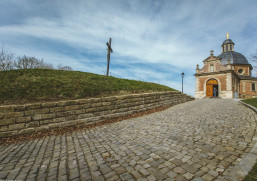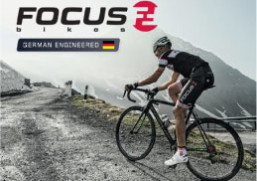Amstel’s Golden Roads
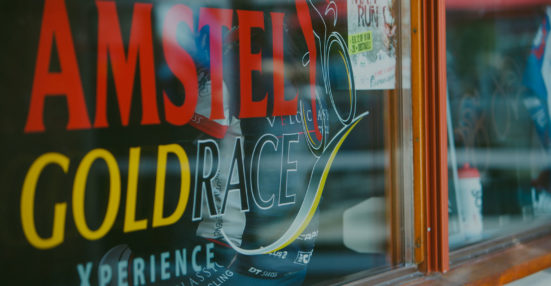
The Province of Limburg has always had strong ties with competitive cycling. As early as September 1869, “a speed trial on wooden velocipedes” was held in Maastricht, which was most likely the first cycling race in the Netherlands. In 1895, Dutchman Mathieu Cordang entered the history books as the first Limburg inhabitant to become a world champion as the rider from Blerick won the amateur motor paced world championships title on the track in nearby Cologne. Cordang, who also enjoyed success at that time as a road racer – finishing runner up in Paris-Roubaix to Maurice Garin in 1897 after he fell in the velodrome and second in Bordeaux-Paris also in 1897 – holds the honor of being the first of a succession of Limburg riders who achieved success at the highest level and who helped script an important chapter in the history of Dutch cycling.
Heading east across Belgium, as one leaves the windswept fields of Flanders and northern France and the lingering pain of riding across the pavé, the E40 is the dividing line between the flatlands of Flanders to the north and the hillier Ardennes to the south. Bordering Belgium on its far eastern reaches and squeezing itself between Germany and Luxembourg is the Dutch region of Limburg. While it is true most of Holland is flat, this southern most part is littered with hills that are crisscrossed with the tiniest of roads – a landscape that is as beautiful for cycling as it is utilitarian for farming. The capital of the region, Maastricht, proudly hosts the Amstel Gold Race every April, and the region has hosted the worlds four times: 1938 won by Belgian Marcel Kint; 1948 won by Belgian Classics legend Briek Schotte; 1979 won by the bespectacled Dutchman Jan Raas and 1998 won by Swiss Oskar Camezind. Additionally, the nearby town of Heerlen hosted the Road World Championships in 1967, where Eddy Merckx won the first of his three elite men world titles.
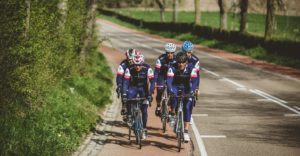
And far afield in northern Holland in the city of Amsterdam, the Amstel Bavarian Bier Brewery was created as a joint stock company, 22 years after the first beer was brewed on the banks of the Amstel river. It would take 74 years after the first running of Liege-Bastone-Liege and across two world wars before professional cyclists would compete in a major Dutch classic. By then, the Spring Classics fraternity would own four of the five monuments and with crossed arms and frowning faces dare a small time beer salesman to create a race that could crack their iron grip on history. The process would be challenging and at times appear fruitless, but ultimately, with the right combination of perseverance, national pride and luck – enormously successful.
Scrolling the cycling archives of 1966, the honor roll of victors in the Spring Classics lists the sports largest figures. Felice Gimondi, Eddy Merckx and Jacques Anquetil all graced the top step on the podium, continuing the growing legacies of Paris-Roubaix, Milan-Sanremo and Liège-Bastogne-Liège. Further down the list, Dutch rider Jan Janssen won Brabantse Pijl but the country’s riders found little success elsewhere. One name that does appear, albeit in an obscure reference, is Herman Krott. A part time racer and beer salesman for the Amstel brewery, Mr. Krott pulled off an enormous publicity stunt for Amstel beer that resulted in the first running of the Amstel Gold Race, from Breda to Meersen. What Mr. Krott failed to do as a rider and promoter in previous years he finally succeeded at doing – bringing international attention to Dutch cycling with a classic intended to rival the monuments. In 1966, the Amstel Gold Race was the new symbol of success for Dutch cycling.
50 years later, there is still a misperception that this race fails to equal the more revered Classics. The primary criticism levied on the Amstel Gold is that it lacks certain identifiable features the more established races claim. But I have asked numerous riders on the start line if they would welcome the title of Amstel Gold winner and not one has said no. While it’s said certain races fail to add up historically, this raises some important questions.
In considering the iconic features of the major spring classics – Milan-Sanremo, the Tour of Flanders, Paris-Roubaix and Liège-Bastogne-Liège – only the Muur van Geraardsbergen in the Tour of Flanders appeared before 1960, and even then it was only during 1950-52, before disappearing until 1970. Milan-Sanremo didn’t include the climb of the Poggio until 1960, the Cipressa in 1982; The Arenberg Forest made its cobbled debut in 1968 and then was excluded from 1974-1984 and in 2005. Every section currently used in Paris-Roubaix appeared after 1968. Liège-Bastogne-Liège has a turbulent history with sketchy archives. Close to cancellation in the fifties before it was grouped with La Flèche Wallonne to form the La Weekend Ardennais, it’s theoretically possible the race’s iconic climb, the Côte de la Redoute, did not appear before this period as well. This places the emphasis of identifiable features in the major classics well into modern history and their appearance close to or after the creation of the Amstel Gold Race, which was not saddled with expectations that come with maintaining a certain historic feel or image.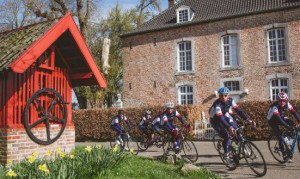
In 1995 former Dutch professional Leo van Vliet stepped into the role as the Amstel Gold’s course director and in 1998 he moved the start to Maastricht. In 2003 he took a bold step in creating the identifiable feature pundits claim it misses-a hilltop finish on the Cauberg in the village of Valkenburg. What took the other races five or more decades to achieve, Krott and Van Vliet accomplished in less than four. Ironically, this puts the Amstel Gold Race decades ahead of its predecessors.
For fans of Amstel, the race’s appeal is exactly that which it is criticized for, and understanding the vision of Krott and Van Vliet requires patience. While Flanders, Milan-Sanremo and Paris-Roubaix are point to point, and Liège-Bastogne-Liège is a large figure eight, the Amstel Gold consists of three loops, each smaller than the previous, navigating the narrow, twisting roads and undulating hills of Limburg, the southern most-and hilliest-province of the Netherlands. Each loop is punctuated with an ascent of the Cauberg, slowly spiraling in on itself, with increasing difficulty. A 135 kilometer loop opens the race with 13 climbs, followed by 64 kilometers and ten climbs, and concludes with a 59 kilometer loop with eight climbs. The Tour of Flanders broke tradition and implemented a circuit to its race that has now been revised to offer a sequence of cobbled climbs that includes the Oude Kwaremont three times and the Paterberg twice. Going further, what if Paris-Roubaix actually started in the Roubaix velodrome before covering 40 sectors of pavé, negotiating the Arenberg Forest twice? Imagine Liège-Bastogne-Liège finishing atop La Redoute, a grand finale in the Ardennes that consumed each of the great climbs twice. Absurd? Maybe. And certainly a break in the tradition that defines each of these races, and something I wouldn’t want to see. But this is where the Amstel Gold doesn’t so much as compete with the older classics as it sets itself apart. And this, while causing many to say it detracts from the normal mold of a classic, is exactly its strength. I love all of these races and have great respect for history, but I also appreciate innovative and creative thinking. In a step away from the traditional, the Amstel Gold Race does not rely on a newspaper as its primary sponsor, so it is not selling stories, but a product. Modern era marketing relies on the craft and intelligence of press director Bennie Ceulen. In the age of dwindling sponsors and disappearing Euros, a 50 year relationship with a corporate sponsor is historic, indeed. The past 28 editions of the Amstel Gold have produced 28 different winners, a claim no other race can make. Applause to Mr. Ceulen and his crew for breaking the mold of history.
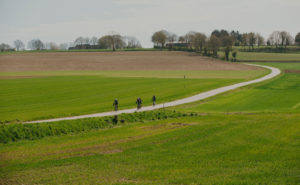 So in the spirit of the Classics, what makes for a successful race? For starters, a challenging course; next, excellent financial support; third, a great venue; and finally, great hospitality. The Amstel Gold Race is four for four. One former rider was once quoted as saying “it’s a shit race with a thousand turns” and one cycling publication’s managing editor, in an inexplicable attempt to show some classics fortitude, rode the course in the snow in February, and condemned the race due to his poor experience. Perhaps both of these men failed to have the required patience, and on one man’s part a certain amount of intellect, to see the vision of Mr. Krott. So where exactly does the beauty of the Amstel Gold Race lay?
So in the spirit of the Classics, what makes for a successful race? For starters, a challenging course; next, excellent financial support; third, a great venue; and finally, great hospitality. The Amstel Gold Race is four for four. One former rider was once quoted as saying “it’s a shit race with a thousand turns” and one cycling publication’s managing editor, in an inexplicable attempt to show some classics fortitude, rode the course in the snow in February, and condemned the race due to his poor experience. Perhaps both of these men failed to have the required patience, and on one man’s part a certain amount of intellect, to see the vision of Mr. Krott. So where exactly does the beauty of the Amstel Gold Race lay?
Limburg is an aberration in a country whose landscape is criss-crossed with canals, bridges, dykes and wind swept tulip fields. For those who say Holland is flat means they have never been through this colorful area with its verdant green hills, brightened yellow when rape flower fields are blooming, lining narrow roads leading through an endless series of charming and obsessively manicured villages and neighborhoods. Its capital, Maastricht, is a 2,000 year old city that energetically marries its historic roots with the avant-garde. 15 kilometers away, the village of Valkenburg is a summer vacation paradise, the satisfaction of a strikingly scenic bike ride washed down with a Gulpener or Leeuw beer in one of the dozens of cafes squeezed between an eclectic mix of international restaurants and shops, all surrounded by authentic old world charm. So popular is this area for Dutch cyclists, it has hosted five world championships and has effectively become the epicenter of cycling in Holland.
The orchestration of climbs that comprises the finish of the Amstel Gold Race may not initially strike fear into the minds and legs of cyclists unfamiliar with them. But the neatly packed finale clearly indicates this is as difficult a finish as there is in cycling. Narrow, steep and in rapid succession, this six climb recipe mixes up a potent cocktail that suits very few, and satisfies only one. Climbed individually, or in a succession stretched across a greater distance would have far less impact, and the narrow roads demand as much attention going down as they do strength going up. The Gulperberg, Kruisberg, Eyserbosweg and Fromberg appear over 13 kilometers, with average grades on the Gulperberg and Eyserbosweg topping 8 percent, and maximum grades reaching twenty percent. This 4,400 meters of climbing sets the stage for the Keutenberg and Cauberg, the transformative link that takes the race out of the shadows of farm fields and onto the blanketed streets of Valkenburg, proudly draped in orange as if prepared to announce the arrival of the Royal Family, one of the few moments in this nation that can equally draw such a crowd, create such anticipation and produce such hysteria. A Dutch victory, missing in this new century, would pronounce a regal ascension for the man worthy of assuming the crown, the new king of Dutch cycling.
The Keutenberg is the penultimate climb, and reeks of the iconography that makes the Spring Classics so great. Long (1700 meters), steep (20 percent) and narrow means it has the potential to stage the final selection before the remaining eleven kilometers to the Cauberg. Both of these climbs have the potential to rival any Classic as the symbol of its race. For the Cauberg, the numbers don’t lie – 255.5 km of racing done, 1500 meters to go, full on to the finish, which is now in Berg en Terblijt, two kilometers after the top. This has succeeded in stretching the finale a bit, and keeps the riders honest to not save it all for the final climb, but for a possible final sprint.
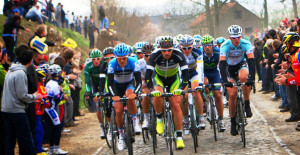 Finally, and most significantly, it is the unique atmosphere of a race that is ultimately what creates the attraction and appeal. The atmosphere on Paris-Roubaix Sunday is dispersed across the pavé, as transient participants and their enthusiasm leads a viewing parade over the barren fields of Northern France. The Tour of Flanders, fortunately, will never escape the iron grip of the Muur van Geraardsbergen, all too briefly one of the most exciting moments in racing every year. Milan-Sanremo packs all of its Italian flair onto the Via Roma in a city that pays more attention to beach goers. The gauntlet of La Redoute is the crown of Liège-Bastogne-Liège, the man whose name is painted 300 times on its slope the next king. All of these are a celebration of the iconic elements, the centerpieces that define the term “Classic”.
Finally, and most significantly, it is the unique atmosphere of a race that is ultimately what creates the attraction and appeal. The atmosphere on Paris-Roubaix Sunday is dispersed across the pavé, as transient participants and their enthusiasm leads a viewing parade over the barren fields of Northern France. The Tour of Flanders, fortunately, will never escape the iron grip of the Muur van Geraardsbergen, all too briefly one of the most exciting moments in racing every year. Milan-Sanremo packs all of its Italian flair onto the Via Roma in a city that pays more attention to beach goers. The gauntlet of La Redoute is the crown of Liège-Bastogne-Liège, the man whose name is painted 300 times on its slope the next king. All of these are a celebration of the iconic elements, the centerpieces that define the term “Classic”.
So then where is the atmosphere at the Amstel Gold? It is everywhere you go to engage in the celebration of Dutch cycling. The Maastricht-Valkenburg corridor and its surrounding villages embrace the weekend of activities, including 12,000 cyclists participating in six different courses in the non-competitive amateur ride (wisely capped to provide a more enjoyable experience) and thousands more lining the hillsides, filling the villages, and consuming the intangible at a pace that is indicative of the Dutch lifestyle-relaxed, and with purpose. All reserved for the recognition of everything that is great about this country, this region, and their sport. The pageantry in Maastricht that is played out on the roads and hills and crosses through Valkenburg links the media, fans, the region and sponsors into a cohesive unit that succeeds in its ultimate goal – to celebrate Dutch cycling. Forgive Mr. van Vliet and Mr. Ceulen and crew if history is not on their side, they seem to be doing just fine creating their own. When I think of this race, I am always reminded of a quote from the late Herman Krott. He doesn’t hide his feelings about his creation. “The day I close my eyes, I do leave something magnificent.”
